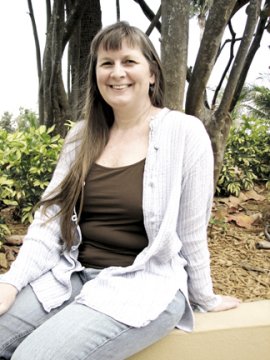Excerpts from the interview:
“I know I'm not a very clever writer and I'm not an intellectual writer, but I'm an emotional writer, and that's something I can work with. When I'm starting out to write, a lot of times I don't know where things are going to go and I'm not clear about what the lead character's voice has to say. I might write a sentence that has three things happening that couldn't all be happening at the same time. Eventually I'll have a clearer picture of what's going on, and I'll crop out the extra things. And then at some point, I usually grab a new sheet of paper (I write longhand) and I have the ending: I know what I'm writing towards. It doesn't feel like 'ideas' -- it feels true.”
*
 “It's a tremendous gift to be a writer, because everywhere I go there are teachers. The library is full of them. In the library or the bookstore, I make sure to walk the shelves, not just to go to a particular shelf every time. I like to explore, and to take home books by people I've never heard of. In the field, I still feel a bit like an outsider. I meet a lot of people who have a strong sense -- and have for a long time -- of being in the groove and writing a certain way, and they're very well educated about the material that's come before. I feel very young in that respect. But what a fascinating group of people! And I'm happy to be here.
“It's a tremendous gift to be a writer, because everywhere I go there are teachers. The library is full of them. In the library or the bookstore, I make sure to walk the shelves, not just to go to a particular shelf every time. I like to explore, and to take home books by people I've never heard of. In the field, I still feel a bit like an outsider. I meet a lot of people who have a strong sense -- and have for a long time -- of being in the groove and writing a certain way, and they're very well educated about the material that's come before. I feel very young in that respect. But what a fascinating group of people! And I'm happy to be here.
“'Map of Dreams' was a longer manuscript I had hoped would be a novel. I read Bruce Chatwin's Songlines and became interested in Aboriginal art, then I started painting. (Actually, I sold my first painting before I ever sold a story. I reached my limit very quickly! But because I had been working with words for so long, it was a nice place to be -- without words.) When I began talking with Golden Gryphon about doing a collection, they asked me to cut it down to novella length. The cut was necessary; I had written it too long.
“'The Chambered Fruit' also came out of something I had originally thought might be a novel about a woman who wrote stories inspired by myth. I wrote three stories based on different myths with different emotional tones, and I learned a lot from that. 'The Chambered Fruit' was inspired by the Persephone myth, and I wanted it to be unrelenting horror without the gruesome.
“Obviously, Map of Dreams is a collection and people can read it in whatever order they want. But I felt it was an opportunity to place some of the darker material in a context of hope. I really wanted to offer that in the work. And I liked the idea of Annie Merchant (from the title story) being the one who wrote the other stories in the book, because by the end of her story she is somebody who, though she's suffered, and continues to suffer a tremendous loss, has also learned how to find happiness within that space.”
*
“I have a few things still in manuscript, including three volumes of very short novels. (I'm still working on the third one.) The first, Pretty Brutal, is sort of a love-gone-wrong metaphor for America, and it's supposed to be about how dissonance really is necessary for harmony. In the second, The Mothers of Voorhisville, a character from the first book (who thinks he's the son of a fallen angel) goes through a town and after he leaves, all the women in the town give birth to babies with wings. Here we have this odd 'other' and they're probably evil, but they're babies. What do we do with them, as a society?
“Again, it was the notion of looking at good and evil and thinking we can easily identify them. If you try to kill a shark, more sharks will come for the blood, so what do we do as a society, as parents? What's our personal responsibility? I wrote this group of books in response to the way things have been going since 9/11: the idea of what we do with good and evil, and also the idea of what being whole means, as a country. There was so much talk and people were so upset about how divided the country was, but this division is part of what's going to create something whole.
“You can't just escape when things get rough -- especially if you're a writer. There's so much disturbing stuff in the world, I think it's more disturbing to pretend there isn't. When I'm writing I can get upset and feel uncomfortable, but I always feel relief for having said it. It's something necessary to me. I'm not writing for anyone else, and it gets in the way if I try to.”


